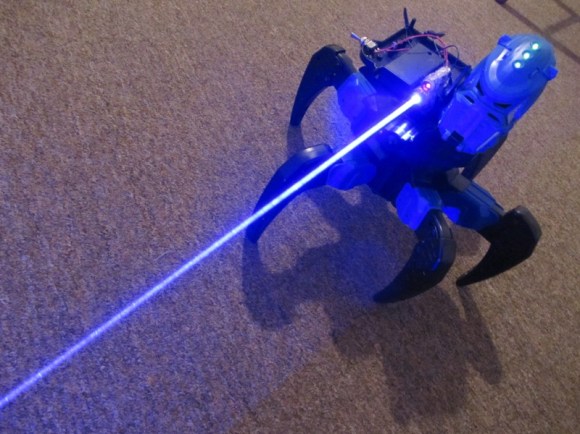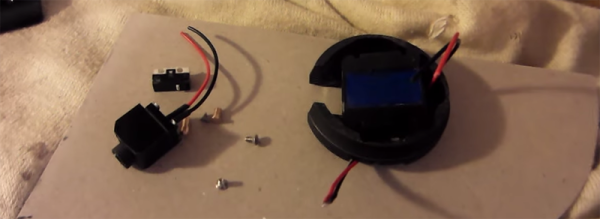Lasers are such a fundamental piece of technology today that we hardly notice them. So cheap that they can be given away as toys and so versatile that they make everything from DVD players to corneal surgery a reality, lasers are one of the building blocks of the modern world. Yet lasers were once the exclusive province of physicists, laboring over expansive and expensive experimental setups that seemed more the stuff of science fiction than workhouse tool of communications and so many other fields. The laser has been wildly successful, and the story of its development is an intriguing tale of observation, perseverance, and the importance of keeping good notes.
3D Printed Engine Chugs Away On Balloon Power
So often, 3D printer owners buy their machines with the promise of freeing themselves from the shackles of commercial manufactured items, and making all sorts of wonderful and useful things to improve their lives. Then they proceed to print a menagerie of good luck cats and toy elephants, that little tugboat, and a host of other pretty but ultimately useless items in garishly colored filament.
Perhaps this is an unfair assessment, but if you have the sneaking feeling that it might just describe you then could we point you at something that while it still has little use is at least interesting to play with. [Gzumwalt]’s single cylinder air engine is as its name suggests, a piston engine that runs on compressed air. You don’t need a shop compressor though, your lungs or an inflated balloon will suffice.
It’s a simple enough design, but it does incorporate two connecting rods, one of which drives a sliding valve. All the files are available for download, and there is a video we’ve placed below the break showing it chugging away nicely from a balloon. It might not be the most useful of engines and it may not bring you good luck, but it beats a plastic menagerie in the interest stakes.
Continue reading “3D Printed Engine Chugs Away On Balloon Power”
200W Laser Bazooka Is Just Silly
We weren’t going to run this one, because, well, it’s just ridiculous. But enough of you have browbeat us by sending in tips to the tipline that we’re going to capitulate. We’re not going to name you all by name, because really, you should be ashamed of yourselves. But you know who you are!
[Styropyro] does a lot of crazy things on YouTube. We really liked his “stuff in a microwave oven” series. He’s also obsessed with lasers and popping black balloons. So he took the laser heads out of four DLP computer projectors (the ones with 24 of those 1.5W Nichia diodes) and combined them. Yup, 200W of 405 445nm blue.
Then he just straps them together and passes them through a lens. It’s not a tight beam, but this thing is really bright. Even though the beam is very loosely focused, it burns stuff. That’s about all you can say. Lots of laser. Boy Howdy!
OK, there, we ran it. Don’t do this at home. It doesn’t require much finesse, and it’s going to get someone blind. Much better to expend your efforts on something more civilized like a projector. At least then you can play vector games on the wall. And stay off my lawn!!! (Kids these days…)
For those that do want to burn stuff, [Joshua Vasquez] published an article yesterday about building a safe laser cutter… much more worth your energy than anything billed as a laser bazooka.
Doing Unsafe Things With A Laser Watch
[Pierce Brosnan]-era James Bond had a beautiful Omega wristwatch. Of course as with any Bond gadget, it couldn’t just tell time; it needed to do something else. This watch had a laser, and [Patrick] figured he could replicate this build.
This is apretty normal 1.5W laser diode build, stuffed into a wrist-mountable device that will kill balloons. This is really a watch, though: press a button and this thing will tell time.
In the video below, [Patrick] goes over what damage this watch can do. He manages to pop some black balloons, burn holes in a CD case, light a few matches, cut cellotape, and put tiny burn marks in his wall. The battery won’t last long – just a few minutes – but more than enough to propel [Patrick] into Youtube stardom.
There are no plans or tutorials for the build, but the teardown [Patrick] shows is pretty impressive. To stuff a laser diode, battery, and clock into a watch-sized compartment, [Patrick] needed to turn down the metal buttons to fit everything into his watch case.
Because the comments for this post will invariable fill up with concern trolls, we’re just going to say, yes, this is incredibly unsafe, no one should ever do this, and it probably kills puppies.
Simple Photo Flash Trigger For Water Balloon Photography

There have been countless projects to make custom photo flash trigger circuits. Usually the circuits react to sound, triggering the camera flash at the moment a certain sound is triggered. That type of trigger can be used to detect the popping of a balloon or shattering of glass. Other triggers detect motion, like a projectile crossing a laser beam for example. [Udo’s] friend had a fun idea to take photos of water balloons popping. Unfortunately neither of those trigger methods would be well suited for this situation. That’s when [Udo] had to get creative.
[Udo] built a unique trigger circuit that uses the water inside the balloon as the trigger. The core component of the circuit is an Arduino. One of the Arduino’s analog pins is configured to enable the internal pull-up resistor. If nothing else is connected to the pin, the Arduino will read 5 volts there. The pin is connected to a needle on the end of a stick. There is a second needle on the same stick, just a short distance away from the first. When these needles pierce the balloon’s skin, the water inside allows for a brief moment of conductivity between the two pins. The voltage on the analog pin then drops slightly, and the Arduino can detect that the balloon has popped.
[Udo] already had a flash controller circuit. He was able to trigger it with the Arduino by simply trying the flash controller’s trigger pin to one of the Arduino’s pins. If the Arduino pulls the pin to ground, it closes the switch on the flash controller and the flash is triggered. Both circuits must share a common ground in order for this to work.
All of the code for [Udo’s] project is freely available. With such spectacular photographs, it’s only a matter of time before we see more of these floating around.
Attacknid Becomes Laser Death Drone

[styroPyro] liked his Attacknid, but decided it needed just a bit more blue death ray laser. We’ve seen [styroPyro’s] high-powered laser hacks before, but this time he’s taken to hacking one of [Jaimie Mantzel’s] Attacknid robots. According to one of the top comments on [styroPyro’s] video—a comment by Attacknid inventor [Jaimie] himself—the robots were meant to be hacked, and [Jamie] is ecstatic.
[styropyro] removed the disk shooter from his Attacknid and used the fire control circuit to activate a 2 watt blue laser. A low powered, red laser pointer serves as a laser sight, allowing you to aim at your target before unleashing the beefy blue laser. As the video shows, 2 watts is a heck of a lot of power. The Attacknid easily pops balloons and sets fire to flash paper. As usual, we urge you to use caution when handling 2 watt lasers, which fall under Class 4: aka the most dangerous class of lasers. Goggles, skin protection, and safety interlocks are the order of the day. [styroPyro] has been working with high power lasers for a few years, and seems to know what he’s doing. That said, we’ll leave the burning lasers to the professionals.
3W Handheld Laser Raises Hope For A Real Lightsaber Someday
That banner image may seem a little bit theatric, but it’s a good representation of what this 3W handheld laser can really do. Turn the thing on in a slightly smoky room and it looks exactly like a thin beam Lightsaber.
What kind of tricks would you expect this thing to perform? Perhaps it’ll pop some black balloons? Prepare to be shocked because it’s orders of magnitude more powerful than that. The video below shows it burning and igniting a collection of items almost instantly. [Styropyro] tested his creation by igniting paper, cardboard, flash paper, flash powder, burning through a stick of wood, and igniting an undisclosed substance at the end of the video. But one of our favorites is when he drives a solar powered toy car with the intense beam.
He pulled the diode from a DLP projector, and drives it with a pair of 18650 Lithium Ion batteries which are commonly found in laptops. He made the enclosure himself. It looks great but we can’t help but wonder if the components would fit in a painstakingly made replica.
Continue reading “3W Handheld Laser Raises Hope For A Real Lightsaber Someday”
















